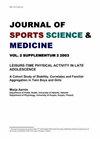Ball-To-Hand Contact Forces Increase Modeled Shoulder Torques during a Volleyball Spike.
IF 2.4
2区 医学
Q2 SPORT SCIENCES
引用次数: 0
Abstract
The volleyball spike is repeated many times in practices and games, presenting a high risk of overuse injury. Previous biomechanical analyses estimating forces on the shoulder during spiking have not included the force exerted on the arm by the ball, because no practical method exists to estimate the contact force between the ball and the hand. The objective of the study was to model the internal shoulder joint reactions while including the measured ball contact force. Ten adolescent female volleyball players performed spikes while we recorded 3D motion capture data for both ball and player. Using an impulse-momentum analysis, we estimated the ball contact force, then included the force in a computational simulation model to estimate the torques produced by the shoulder. The study found that post-contact ball velocities range from 8.6 m/s - 18.2 m/s with net forces between 238 N - 672 N. Most notably, when the ball contact force was included, the average modeled internal shoulder torque to internally rotate the arm increased from -26 N-m to +44 N-m (p < 0.001). These data suggest that neglecting the contact force may risk misinterpreting connections between biomechanics and injury due to spiking. More accurate joint mechanics models will lead to better injury prevention recommendations for volleyball players of all ages.在排球扣球过程中,球与手的接触力增加了模型肩部扭矩。
排球扣球在练习和比赛中重复多次,呈现出过度使用损伤的高风险。以前的生物力学分析估计扣球时肩膀上的力没有包括球施加在手臂上的力,因为没有实用的方法来估计球和手之间的接触力。该研究的目的是模拟肩关节内部反应,同时包括测量的球接触力。10名青少年女排球运动员在我们记录球和运动员的3D动作捕捉数据的同时进行了刺突。通过脉冲动量分析,我们估计了球的接触力,然后将力纳入计算仿真模型,以估计肩部产生的扭矩。研究发现,接触后的球速度范围为8.6 m/s - 18.2 m/s,净力在238 N- 672 N之间。最值得注意的是,当球接触力包括在内时,用于内部旋转手臂的平均内部肩部扭矩从-26 N-m增加到+44 N-m (p < 0.001)。这些数据表明,忽视接触力可能会导致误解生物力学与刺突损伤之间的联系。更准确的关节力学模型将为所有年龄段的排球运动员提供更好的损伤预防建议。
本文章由计算机程序翻译,如有差异,请以英文原文为准。
求助全文
约1分钟内获得全文
求助全文
来源期刊
CiteScore
5.60
自引率
6.20%
发文量
56
审稿时长
4-8 weeks
期刊介绍:
The Journal of Sports Science and Medicine (JSSM) is a non-profit making scientific electronic journal, publishing research and review articles, together with case studies, in the fields of sports medicine and the exercise sciences. JSSM is published quarterly in March, June, September and December. JSSM also publishes editorials, a "letter to the editor" section, abstracts from international and national congresses, panel meetings, conferences and symposia, and can function as an open discussion forum on significant issues of current interest.

 求助内容:
求助内容: 应助结果提醒方式:
应助结果提醒方式:


